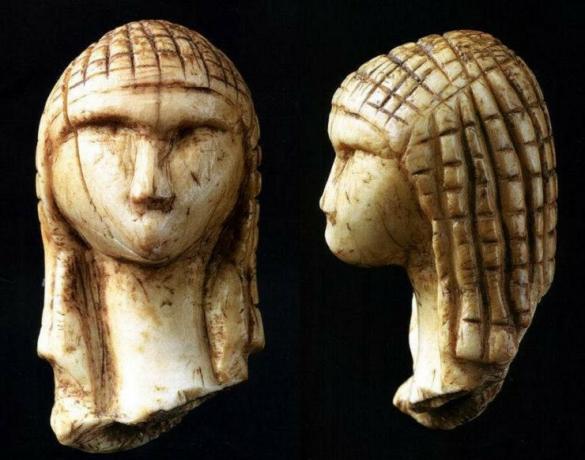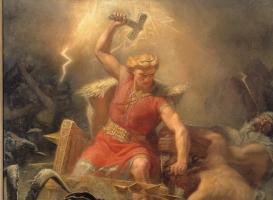The Venus of Willendorf: characteristics of this prehistoric sculpture
In 1908, an expedition led by archaeologists Josef Szombathy, Hugo Obermaier, and Josef Bayer was excavating at Willendorf in Lower Austria, very close to the Danube. One of the workers, J. Veran, made a unique find: a very small statuette, about 11 cm long and 5 cm wide, representing a woman with prominent feminine attributes. She was baptized as Venus of Willendorf, and its execution was dated to around 30,000 BC. c.
What was the meaning of this statuette? What use had it had during the Paleolithic? Was it true, as early scientists assumed, that she represented the ideal of feminine beauty of the time? Or perhaps it was a representation of the Mother Goddess?
In this article we will try to unravel the mysteries of the Venus of Willendorf which, as you will see, are not few.
- Related article: "The 6 stages of Prehistory"
Characteristics of the Venus of Willendorf
Although the discovery was truly sensational, Willendorf's was not the first Paleolithic Venus to be found in Europe. In 1893, the team of archaeologist Édouard Piette found in Brassempouy, France, an interesting female head carved in mammoth ivory and of tiny dimensions (3.65 x 2.2 cm).
Despite its smallness, the figurine was exquisitely delicate: the features were clearly carved (except for the mouth, which was non-existent) and showed an elaborate hairstyle, whose solution using grids made many specialists think that it was a hood.

That of Willendorf, despite being also baptized as Venus, has very different characteristics. For a start, It has no face: it only presents a kind of hat (or what could also be a hairstyle, based on twisted braids) that covers almost the entire head. In addition, while the Brassempouy Venus lacks a body, the Willendorf Venus shows voluminous forms, with bulging feminine attributes (vulva, breasts, hips).

The first scientists who studied these Venuses (and the many others that appeared throughout throughout the European geography, and which corresponded to more or less the same period) thought that the statuettes they could be capturing what in the Upper Paleolithic was the ideal of feminine beauty. That is why they called all the figurines "Venus", alluding to the goddess of beauty. However, throughout the 20th century this theory has been dismantled in favor of others that specialists have considered more plausible. Let's see what it is.
- You may be interested in: "5 examples of gender roles (and their effects on society)"
The Great Primal Goddess
The anatomy shown by these Venuses (mostly with very bulging genitals and breasts) has suggested the possibility that they were amulets that ensured fertility and abundance. In fact, the small size of the statuettes shows their "movable" nature; no doubt they were made to be easily moved from one place to another.
Let us remember that the European populations of the Upper Paleolithic (that is, a period that covers from 40,000 to 10,000 B.C. C.) were nomads. The fact that most Venuses (and Willendorf's is no exception) lack feet reinforces this theory, since they do not have a support on which to stand. Were they then worn around the neck?
On the other hand, the enormous presence of female figurines (more than a hundred have been found) could demonstrate the privileged position that women would hold in these groups of hunter-gatherers. Following this theory, it would be quite probable that the woman was invested with an almost sacred character, since she is the depositary of the miracle of life.
This would tie in, of course, with the Great Goddess theory, which holds that long before the arrival of the Indo-European peoples and their religion, there existed in Europe a current of adoration of a Mother Goddess, at the same time giver and denier of life, responsible for the birth and death. Then, the famous Venus would not be anything other than representations of this Great Primal Goddess.
- Related article: "Archaeology: what is it and what does this discipline study"
amulets against death
However, new theories have emerged lately that are just as interesting and worth considering. It is the case of the study Upper Paleolithic Figurines Showing Women with Obesity may Represent Survival Symbols of Climatic Change, from the University of Colorado, where the authors propose that, in fact, the overweight of the Venuses would actually be a protection against famine and death.
The theory makes sense if we take into consideration the period in which the figurines were carved, which coincides with the last Great Ice Age. The researchers realized that the body volume of prehistoric Venuses grew at as they were closer to the glaciers or closer in time to the great glaciations. All this led them to think that, faced with the fear of starvation, Paleolithic human beings began to value well-nourished bodies as a guarantee of group survival.
And it is not true that all the Venus found have a large anatomical volume. According to Henri Delporte, the typology of Venus would change according to the region in which they were found, which seems to fit more or less with the theory of the University of Colorado. Thus, for example, while the Venus of Willendorf has bulging breasts and hips, We have other examples such as the Venus of Mal'ta, in Russia, which do not present any exaggeration traits. anatomical.
A common culture?
Despite the differences described above, it is true that all the European Venuses of the period show some similar characteristics: they are representations of stereotyped women and are very small in size (none exceeds 25 cm). Thus, it can be stated that there was a fluid exchange between the human groups established in Europe during the Paleolithic.
In fact, a recent study by an interdisciplinary team, made up of experts from the University of Vienna and the Museum of Natural History of the same city, has shown that the material with which the Venus of Willendorf is made is not found anywhere near where it was found.
The statuette was carved in oolite rock, a very porous material that facilitates modelling, and later polychromed with red ocher. However, the closest region where deposits of this type are found is in northern Italy. and, to a lesser extent, in the Ukraine, which shows that Paleolithic men and women moved constantly.
If the culture of the Venus occurred throughout Europe, from the French Pyrenees to Siberia, the following information is very curious: there is no record of any Venus in the Iberian Peninsula, which only increases the questions about the history and meaning of these prehistoric representations.


